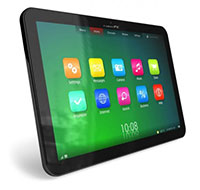In a previous post we looked at the advantages of tablet-based learning. This time around we’ll investigate the options available when you’re buying a tablet.
 While there are many different tablets on the market, they can all be categorised according to the software platform they run. Just like a computer runs on Microsoft Windows, Mac OSX or Linux, a tablet also has a so-called operating system. In choosing a tablet, then, you have three main alternatives:[1]
While there are many different tablets on the market, they can all be categorised according to the software platform they run. Just like a computer runs on Microsoft Windows, Mac OSX or Linux, a tablet also has a so-called operating system. In choosing a tablet, then, you have three main alternatives:[1]
- An iOS-based tablet:
- Apple iPad (starting at around R4 500 for an older iPad 2 with WiFi)
- Apple iPad Mini (starting at around R3 500 for a first-generation device with WiFi)
- An Android-based tablet:
- Samsung Galaxy Tab (starting at around R6 000 for an older Galaxy Tab 2 P5100 with WiFi)
- Samsung Galaxy Note (costing around R7 000 for a Galaxy Note N7100 with WiFi+3G)
- Lower-end alternatives by other companies (costing as little as R1 500)
- A Windows-based tablet:
- Lenovo and Dell tablets (starting at around R5 000)
The first two groups are by far the most popular. Although many people will argue that an iPad is better than a Samsung Galaxy Tab – or vice versa – choosing between the two is ultimately a matter of taste. However, if you own a smartphone (e.g. an iPhone or a Samsung Galaxy), it makes sense to get a tablet that runs the same software so that you can easily share dataandapps between the two.
If cost is your biggest concern, your best option will be to get a lower-end Android tablet. These tablets should be able to do most things that their Samsung big brother can do, albeit at a slower pace and without some of the enhancements that come with Samsung devices. When buying such a tablet, make sure that the battery life is good (you’ll want at least 8 hours of battery life to get through a full day of classes) and that the tablet has enough storage space (less than 16 GB will fill up rather rapidly).
For detailed specifications on available tablets, click here (downloadable pdf)
TIP: Stellenbosch University is part of the national Student Technology Programme (STP), which offers laptops and tablets at reduced prices. Take a look at their website: www.stp.ac.za. Mid-September new tablets will also be added to the list.
[1] Please note that the listed prices of tablets are merely intended as a general guideline and were current as of January 2014.
[ARTICLE BY JOHANNES JONKER]
In `n vorige skrywe het ons gekyk na die voordele van tabletgebaseerde leer. Hierdie keer stel ons ondersoek in na die verskeie opsies beskikbaar wanneer jy een wil koop.
Hoewel daar ’n groot verskeidenheid tablette op die mark is, kan hulle almal in terme van die sagtewareplatform waarop hulle loop, gekategoriseer word. Net soos ’n rekenaar op Microsoft  Windows, Mac OSX of Linux loop, het ’n tablet ook ’n sogenaamde bedryfstelsel. Wanneer jy dus ’n tablet kies, het jy drie vername keuses[1]:
Windows, Mac OSX of Linux loop, het ’n tablet ook ’n sogenaamde bedryfstelsel. Wanneer jy dus ’n tablet kies, het jy drie vername keuses[1]:
- ’n iOS-gebaseerde tablet:
- Apple iPad (begin teen omtrent R4 500 vir ’n ouer iPad 2 met WiFi)
- Apple iPad Mini (begin teen omtrent R3 500 vir ’n eerste generasie toestel met WiFi)
- ’n Android-gebaseerde tablet:
- Samsung Galaxy Tab (begin teen omtrent R6 000 vir ’n ouer Galaxy Tab 2 P5100 met WiFi)
- Samsung Galaxy Note (kos omtrent R7 000 vir ’n Galaxy Note N7100 met WiFi+3G)
- Goedkoper alternatiewe van ander maatskappy (kos so min as R1 500)
- ’n Windows-gebaseerde tablet:
- Lenovo en Dell (begin teen omtrent R5 000)
Die eerste twee groepe is verreweg die gewildste. Hoewel baie mense sal argumenteer dat ’n iPad beter is as ’n Samsung Galaxy Tab – of omgekeerd – is enige keuse tussen die twee hoofsaaklik ’n geval van smaak. As jy egter ’n slimfoon het (bv. ’n iPhone of ’n Samsung Galaxy), maak dit sin om ’n tablet te koop wat op dieselfde sagteware loop sodat jy maklik data en apps tussen die twee kan deel.
Indien koste jou grootste bekommernis is, sal jou beste opsie wees om ’n goedkoper Android-tablet te kry. Hierdie tablette behoort feitlik alles te kan doen wat hulle Samsung grootboet doen, hoewel ietwat stadiger en sonder etlike van die verbeterings wat met Samsung toestelle kom. Wanneer jy egter so ’n tablet koop, moet jy seker maak die batterylewe is goed (jy sal ten minste 8 ure se batterylewe wil hê om deur ’n dag se klasse te kom) en dat die tablet voldoende stoorruimte het (minder as 16 GB sal bietjie vinnig vol word).
Vir gedetaileerde spesifikasies oor beskikbare tablette, kliek hier (aflaaibare pdf)
WENK: Die Universiteit Stellenbosch vorm deel van die nasionale Studente Tegnologie Program (STP), wat skootrekenaars en tablette teen verlaagde pryse aanbied. Kyk gerus na hulle webwerf: www.stp.ac.za. Teen middel-September sal daar nog modelle bygevoeg word, onthou dus om gereeld te gaan kyk.
[1] Let wel dat die gelyste pryse van die tablette bloot as ’n algemene riglyn dien en in Januarie 2014 geldig was.


Thanks for letting us know Jonathan!
The Mecer S10 with 10inch screen, 32 gig onboard with SD card expansion slot, and 3G is brilliant with better performance than the much more expensive Samsung